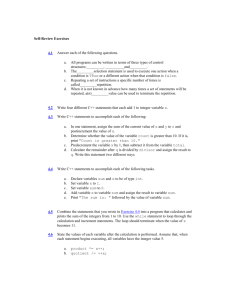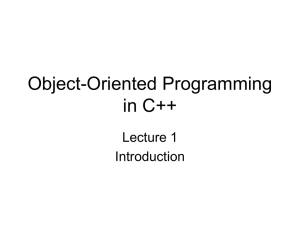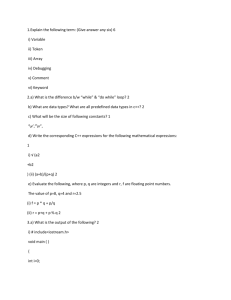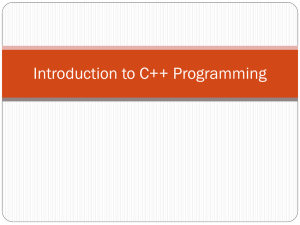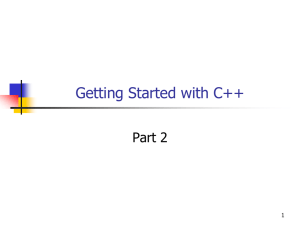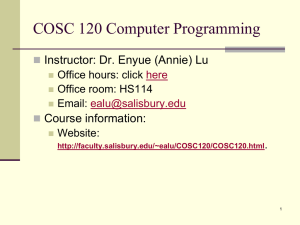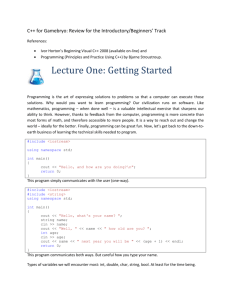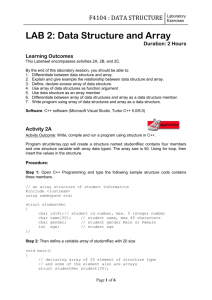C++ Self-Review Exercises: Basic Programming Concepts
advertisement
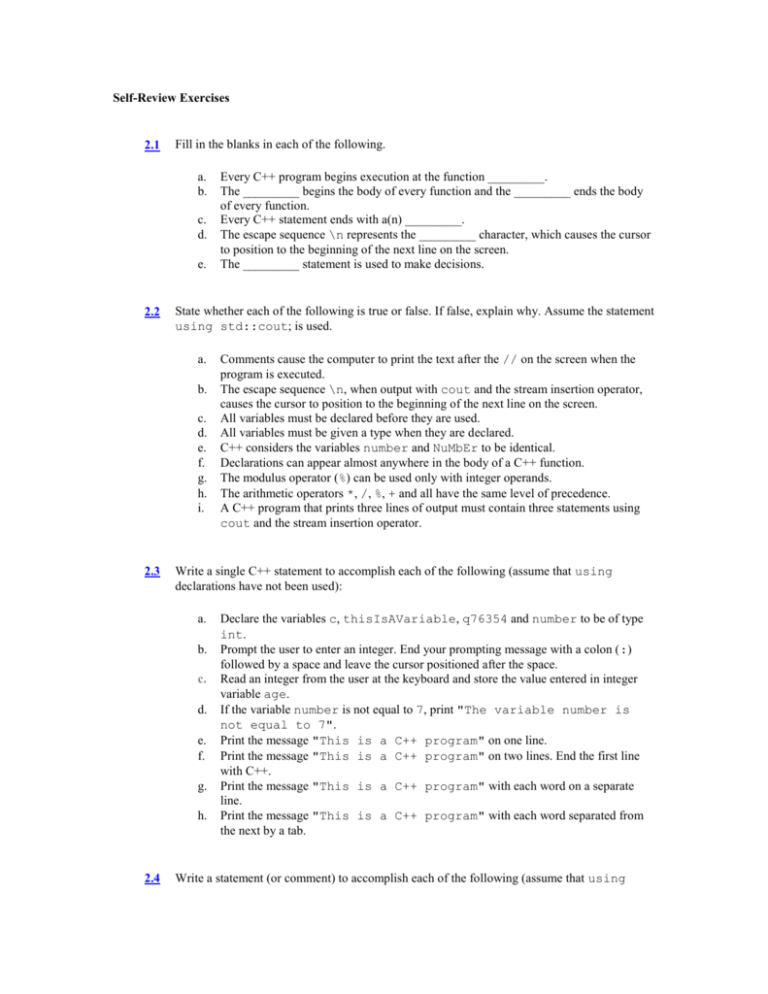
Self-Review Exercises
2.1
Fill in the blanks in each of the following.
a.
b.
c.
d.
e.
2.2
State whether each of the following is true or false. If false, explain why. Assume the statement
using std::cout; is used.
a.
b.
c.
d.
e.
f.
g.
h.
i.
2.3
Comments cause the computer to print the text after the // on the screen when the
program is executed.
The escape sequence \n, when output with cout and the stream insertion operator,
causes the cursor to position to the beginning of the next line on the screen.
All variables must be declared before they are used.
All variables must be given a type when they are declared.
C++ considers the variables number and NuMbEr to be identical.
Declarations can appear almost anywhere in the body of a C++ function.
The modulus operator (%) can be used only with integer operands.
The arithmetic operators *, /, %, + and all have the same level of precedence.
A C++ program that prints three lines of output must contain three statements using
cout and the stream insertion operator.
Write a single C++ statement to accomplish each of the following (assume that using
declarations have not been used):
a.
b.
c.
d.
e.
f.
g.
h.
2.4
Every C++ program begins execution at the function _________.
The _________ begins the body of every function and the _________ ends the body
of every function.
Every C++ statement ends with a(n) _________.
The escape sequence \n represents the _________ character, which causes the cursor
to position to the beginning of the next line on the screen.
The _________ statement is used to make decisions.
Declare the variables c, thisIsAVariable, q76354 and number to be of type
int.
Prompt the user to enter an integer. End your prompting message with a colon (:)
followed by a space and leave the cursor positioned after the space.
Read an integer from the user at the keyboard and store the value entered in integer
variable age.
If the variable number is not equal to 7, print "The variable number is
not equal to 7".
Print the message "This is a C++ program" on one line.
Print the message "This is a C++ program" on two lines. End the first line
with C++.
Print the message "This is a C++ program" with each word on a separate
line.
Print the message "This is a C++ program" with each word separated from
the next by a tab.
Write a statement (or comment) to accomplish each of the following (assume that using
declarations have been used):
a.
b.
c.
d.
e.
f.
g.
State that a program calculates the product of three integers.
Declare the variables x, y, z and result to be of type int (in separate statements).
Prompt the user to enter three integers.
Read three integers from the keyboard and store them in the variables x, y and z.
Compute the product of the three integers contained in variables x, y and z, and
assign the result to the variable result.
Print "The product is " followed by the value of the variable result.
Return a value from main indicating that the program terminated successfully.
2.5
Using the statements you wrote in Exercise 2.4, write a complete program that calculates and
displays the product of three integers. Add comments to the code where appropriate. [Note:
You will need to write the necessary using declarations.]
2.6
Identify and correct the errors in each of the following statements (assume that the statement
using std::cout; is used):
a.
if ( c < 7 );
cout << "c is less than 7\n";
b.
if ( c => 7 )
cout << "c is equal to or greater than 7\n";
Answers to Self-Review Exercises
2.1
2.2
a) main. b) left brace ({), right brace (}). c) semicolon. d) newline. e) if.
a.
b.
c.
d.
e.
f.
g.
h.
i.
2.3
a.
b.
False. Comments do not cause any action to be performed when the program is
executed. They are used to document programs and improve their readability.
True.
True.
True.
False. C++ is case sensitive, so these variables are unique.
True.
True.
False. The operators *, / and % have the same precedence, and the operators + and have a lower precedence.
False. A single cout statement with multiple \n escape sequences can print several
lines.
int c, thisIsAVariable, q76354, number;
std::cout << "Enter an integer: ";
c. std::cin >> age;
d.
if ( number != 7 )
std::cout << "The variable number is not equal to 7\n";
e.
f.
g.
h.
2.4
a.
b.
int
int
int
int
c.
d.
e.
f.
g.
2.5
std::cout
std::cout
std::cout
std::cout
<< "This is a C++ program\n";
<< "This is a C++\nprogram\n";
<< "This\nis\na\nC++\nprogram\n";
<< "This\tis\ta\tC++\tprogram\n";
// Calculate the product of three integers
x;
y;
z;
result;
cout << "Enter three integers: ";
cin >> x >> y >> z;
result = x * y * z;
cout << "The product is " << result << endl;
return 0;
(See program below)
1 // Calculate the product of three integers
2 #include <iostream> // allows program to perform input and
output
3
4 using std::cout; // program uses cout
5 using std::cin; // program uses cin
6 using std::endl; // program uses endl
7
8 // function main begins program execution
9 int main()
10 {
11
int x; // first integer to multiply
12
int y; // second integer to multiply
13
int z; // third integer to multiply
14
int result; // the product of the three integers
15
16
cout << "Enter three integers: "; // prompt user for
data
17
cin >> x >> y >> z; // read three integers from user
18
result = x * y * z; // multiply the three integers;
store result
19
cout << "The product is " << result << endl; // print
result; end line
20
21
return 0; // indicate program executed successfully
22
2.6
} // end function main
a.
Error: Semicolon after the right parenthesis of the condition in the if statement.
Correction: Remove the semicolon after the right parenthesis. [Note: The result of this
error is that the output statement will be executed whether or not the condition in the
if statement is true.] The semicolon after the right parenthesis is a null (or empty)
statementa statement that does nothing. We will learn more about the null statement in
the next chapter.
b.
Error: The relational operator =>.
Correction: Change => to >=, and you may want to change "equal to or greater than"
to "greater than or equal to" as well.


